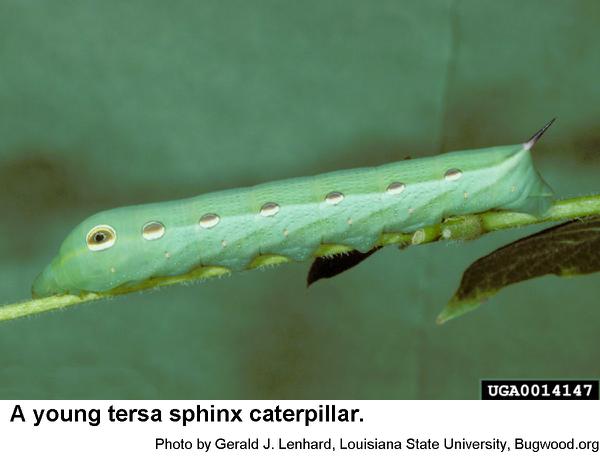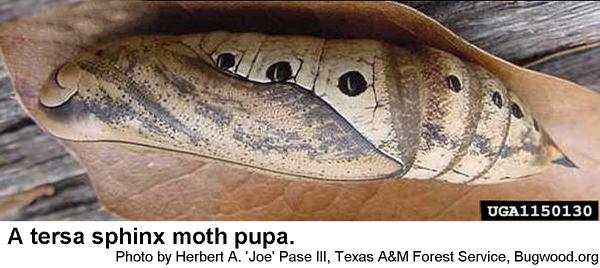Description and Biology
The tersa sphinx moth, Xylophanes tersa, is a fairly large moth with a wingspan of 23/8 to 31/8 inches. The forewings are grayish brown with a pale line that extends to the tip. The pale line is set off by darker lines on each side. The hind wings have large black patches with contrasting pale spots. The abdomen is brown to cinnamon with barely contrasting lines along the back and a paler line along the side. At sunset, moths begin drinking nectar from flowers. Females release a pheromone that calls males from a considerable distance. Males come to lights, but females are seldom taken in that way. Tersa sphinx caterpillars are called "sphinxes" because they can rear up slightly and retract the head and three thoracic segments into the abdomen, a posture that somewhat resembles a sphinx. These caterpillars are snake mimics with a realistic pair of light-ringed eyespots on the first abdominal segment. Tersa sphinx caterpillars are variable in appearance. Some are pale green with pale eye spots whereas others may be dark with vivid eyespots. All specimens have a noticeable "horn" at the rear. These caterpillars grow to about 3 inches long. When mature, tersa sphinx caterpillars crawl to the soil surface and burrow into plant debris to molt into a pupa. The pupa is tan with eye spots down the abdomen. We have two or more generations per year in North Carolina.
Host Plants
Tersa sphinx moths visit Chinese violet, common milkweed, four o' clocks, honeysuckle, and even prairie white fringed orchid for nectar. Their caterpillars feed on pentas as well as broadleaf buttonweed, candy corn vine, catalpa, firebush, and smooth buttonplant. They have also been reported from joe-pie weed.
Residential Recommendations
In spite of the threatening appearance of horn at the rear of tersa sphinx caterpillars, these insects are harmless and can be plucked from their host plants and trampled under foot. In the rare case that there are too many caterpillars for manual control, any insecticide labeled for landscape use should give more than adequate control.
References
- Flowering Plants Visited by Xylophanes tersa. Hilty, J. 2017. Illinois Wildflowers.
- Tersa Sphinx. Contributed by Hollenbeck, J. 2006. BugGuide. Identification, Images, & Information, For Insects, Spiders & Their Kin, For the United States & Canada. Iowa State University Department of Entomology.
- Xylophanes tersa (Linnaeus, 1771), TERSA SPHINX, Tersa Sphinx Moth. Anonymous. 2019 (updated). Discover Life.
- Extension Plant Pathology Publications and Factsheets
- Horticultural Science Publications
- North Carolina Agricultural Chemicals Manual
For assistance with a specific problem, contact your local Cooperative Extension Center.
This Factsheet has not been peer reviewed.
Publication date: Sept. 13, 2017
Reviewed/Revised: June 22, 2022
Recommendations for the use of agricultural chemicals are included in this publication as a convenience to the reader. The use of brand names and any mention or listing of commercial products or services in this publication does not imply endorsement by NC State University or N.C. A&T State University nor discrimination against similar products or services not mentioned. Individuals who use agricultural chemicals are responsible for ensuring that the intended use complies with current regulations and conforms to the product label. Be sure to obtain current information about usage regulations and examine a current product label before applying any chemical. For assistance, contact your local N.C. Cooperative Extension county center.
N.C. Cooperative Extension prohibits discrimination and harassment regardless of age, color, disability, family and marital status, gender identity, national origin, political beliefs, race, religion, sex (including pregnancy), sexual orientation and veteran status.





